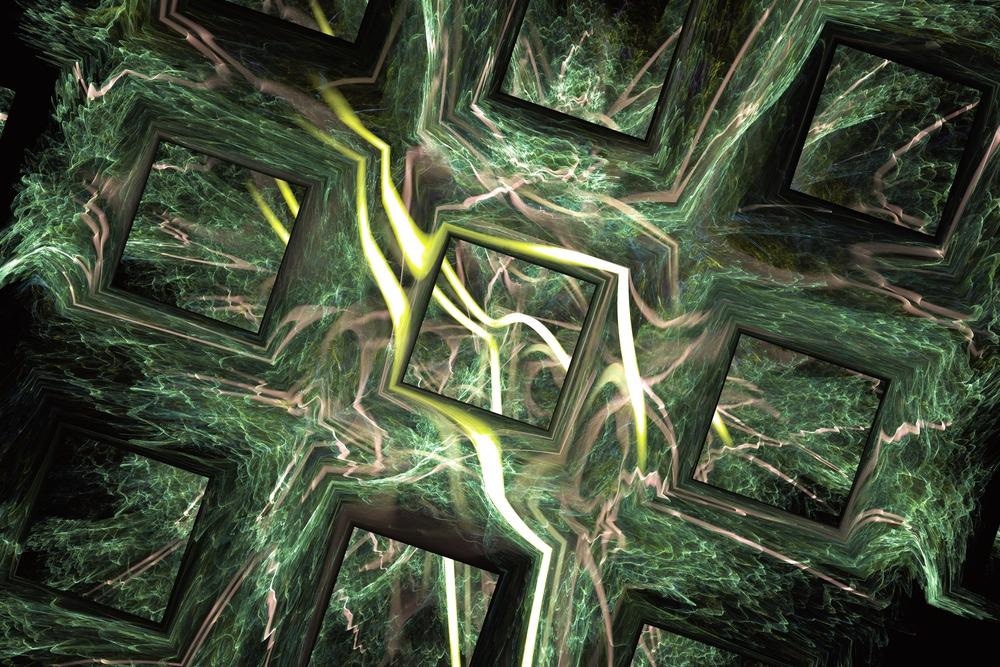A team of researchers recently published a paper in the journal ACS Applied Nano Materials that demonstrated the effectiveness of computer simulations in creating defect-free micro- and nanostructured patterns on surfaces through ultraviolet (UV) nanoimprinting.

Study: Finite Element Simulations of Filling and Demolding in Roll-to-Roll UV Nanoimprinting of Micro- and Nanopatterns. Image Credit: Eugenock/Shutterstock.com
Background
Surfaces featuring micro- or nanopatterns are often considered for several technological applications owing to their powerful and versatile properties.
Roll-to-roll (R2R) UV nanoimprinting, a nanoimprinting technique based on UV nanoimprint lithography, can fabricate such patterns over large areas at a low cost and high throughput. Thus, R2R UV nanoimprinting technique is typically preferred to manufacture surfaces with micro-and nanostructured patterns on a mass scale.
These patterns are achieved by initially pressing a rotating cylindrical template with the proposed surface pattern into a liquid imprint resin, and then solidifying the resin using UV light-induced polymerization.
Finally, the resin is demolded from the cylindrical template. The sizes of the patterns fabricated by this method generally range from tens of micrometers to sub-100 nanometers. The throughputs achieved during the fabrication are in the order of m2/min.
Batch UV nanoimprinting, another variant of this process, is also employed to obtain nanopatterned surfaces. Batch UV nanoimprinting involves imprinting a pattern on a static surface by a step-and-repeat (S&R) mode.
Both UV imprinting methods can be used to efficiently fabricate several micro-and nanostructures in different applications related to microfluidics, optics, biomimetics, and electronics.
Defects in the fabricated structures are one of the major issues associated with this technique, specifically when a large number of imprints are done in a continuous process.
Defects mainly happen when air gets entrapped in the nanofabricated structures during filling, and the structures subsequently fracture during demolding.
Preventing such defects can be time- and cost-intensive as it is primarily done by the trial-and-error method. Computer simulations can potentially assist in optimizing the defect prevention process by simulating specific cases in advance to identify potential issues and provide a quantitative and deeper understanding of the defect generation mechanism.
Simulations of two crucial stages, demolding and filling, in UV nanoimprinting that are prone to defects, are required to prevent defects.
The objective of this study was to obtain a better theoretical understanding of the defect generation mechanism and predict defects for certain process and material parameters.
The Study
In this study, researchers developed three-dimensional (3D) and two-dimensional (2D) computer simulations of demolding and filling stages in UV nanoimprinting using COMSOL Multiphysics, a commercial finite element software, and validated the simulations by corresponding S&R and R2R experiments.
The imprint resin was prepared by mixing hexanediol diacrylate and Ebecryl 8402 in the ratio of 1:1. The viscosity of the imprint resin was 135 and 35 mPa-s at room temperature and 50oC temperature, respectively.
Manual UV nanoimprinting was performed by initially depositing a small drop of resin on the nickel template, and then carefully bringing the substrate foil poly(ethylene terephthalate) (PET) in contact with the resin drop. Subsequently, the foil was slowly released to spread the resin on the template.
A custom-built 365 nm UV light-emitting diode (LED) lamp was employed for 20 s to cure the resin at 100 mW/cm2 intensity. Eventually, the resin was manually demolded by detaching the imprint from the nickel template.
A custom-built R2R machine was used to perform R2R UV nanoimprinting.
A PET foil was utilized as substrate and the resin was coated on the substrate by slot-die coating. A patterned nickel shim was used as a template. A 395 nm UV LED was employed to cure the resin at 14 W/cm2 intensity.
The elastic modulus, size, fillet radius, and sidewall angle of the patterns were evaluated to understand the demolding process. Additionally, demolding by S&R and R2R nanoimprinting methods were compared in terms of the radius of rotation.
Observations
Micro- and nanostructured patterns were successfully fabricated using the manual and R2R UV nanoimprinting techniques. An adequate resin thickness; low-aspect-ratio features; high substrate contact angles; low template contact angles; low resin velocity and viscosity; and low inclined sidewalls in the resin supported the filling process. Detrimental values of any of these factors were compensated by optimizing the other factors.
The filling of nanoscale patterns was considerably easier compared to the filling of microscale patterns owing to the enhanced dissolution of gas. The size of the fabricated patterns played no significant role in air entrapment during the filling process.
For demolding, a large radius of rotation, rounded corners, inclined sidewalls, and small patterns was found to be advantageous.
During demolding, the dominant effect for microstructures was friction, whereas, for nanostructures, it was adhesion. The most vulnerable positions of a pattern geometry were identified successfully by a 3D demolding simulation.
To summarize, the findings of this study demonstrated the impact of different parameters on demolding and filling during UV nanoimprinting, both experimentally and by computer simulations, which can help in optimizing the process parameters and materials associated with the UV nanoimprinting process to design a UV nanoimprinting technique that is defect-free in practice.
Reference
Palfinger, U., Nees, D., Kuna, L. et al. (2022) Finite Element Simulations of Filling and Demolding in Roll-to-Roll UV Nanoimprinting of Micro- and Nanopatterns. ACS Applied Nano Materials https://pubs.acs.org/doi/10.1021/acsanm.1c04059
Disclaimer: The views expressed here are those of the author expressed in their private capacity and do not necessarily represent the views of AZoM.com Limited T/A AZoNetwork the owner and operator of this website. This disclaimer forms part of the Terms and conditions of use of this website.